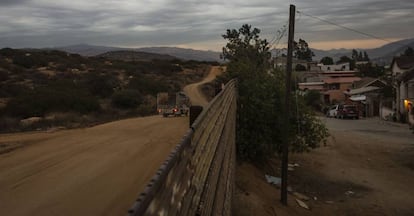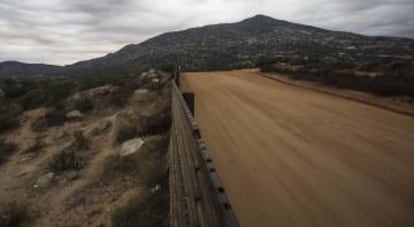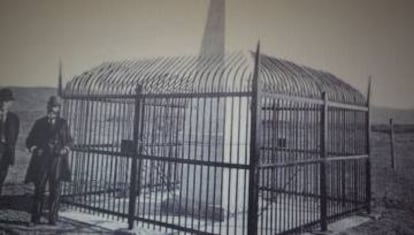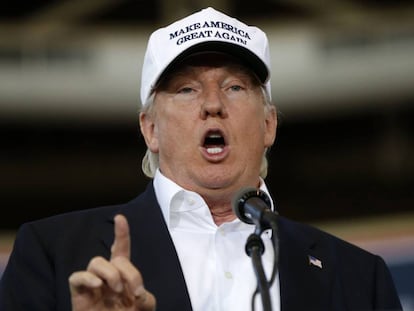Why Donald Trump’s ‘Great Wall of Mexico’ is already a reality
Large sections of the US-Mexico border are divided by a three-meter-high barrier

The wall that Republican candidate Donald Trump has been dreaming of is made of iron, and you can already touch it. It is rough, cold in the morning and burning hot in the afternoon sun. That wall he longs for is three meters high, and rusted through in places allowing visitors to see there is only an open field on the other side.
When Trump proposed the construction of a great border wall between the United States and Mexico at the Republican National Convention in Cleveland in July, his followers cheered and stood up to shout “Build the wall!” as if they were at a Super Bowl game.
The barrrier climbs like a fat worm over hills – a miniature Tex-Mex Chinese Wall
Thousands of kilometers away, in Tecate – a Mexican city of 65,000 residents – Minerva Chávez smiles when she hears talk of that wall, because she has been staring the enormous metal sheet in the face every time she has gone outside to hang her laundry for the last 15 years.
The United States’ iron wall is just a few meters from her balcony.
“I find it funny when Trump threatens to build a wall that we already have here. What does he plan to do now? Electrify it? Build a cement wall?” asks Minerva, as she stands next to the metal fence.
The Gulf War of 1991 is one of the reasons that the rusted barrier is the only thing Minerva can see from her balcony.
To enter into Kuwait, the American military furnished the sandy desert floor with enormous metal sheets that fitted together like the pieces of a puzzle, so that pilots could land their planes safely. In 1993, with the conflict over and Bill Clinton the newly elected US president, those metal plates were taken to the US-Mexican border, where they were recycled into a border fence.

Democrats raised the now-controversial wall, and they did so without creating any fuss – just as Barack Obama quietly became the American president who has deported the largest number of undocumented immigrants (2.6 million in less than eight years) in American history.
In 1993, Clinton replaced the barbed-wire fence at the border with an iron wall and, since then, residents in the neighborhood of Refugio de Tecate no longer see alder trees and oaks when they look out toward the horizon. They stare right at that metal sheet.
Less than an hour away, on the beach in Tijuana, a marble monument built in 1848 commemorates the day Mexico’s interim President Manuel de la Peña and US President James Polk agreed to the current border lines. This boundary stone has a brother in Tamaulipas, on the other side of the country, 3,185 kilometers away, or nearly the same as the distance between Madrid and Moscow.
The metal sheets which make up the fence were originally used by the US military to land planes during the Gulf War
There is currently a physical wall along one-third of the US-Mexican border. It begins at Tijuana beach and stretches to the east, crossing cities such as Tecate and Mexicali. Then it climbs up and down like a fat worm over hills in California, Arizona and New Mexico where there are only deer roaming the landscape – a miniature Tex-Mex Chinese Wall.
Another third of the border is fortified with a virtual wall of infrared cameras, thermal sensors, X-ray technology, and 21,000 border patrol agents, 518% up on two decades ago, according to a report by El Colegio de la Frontera Norte and the North American Center for Transborder Studies.
The last third of the border is the cheapest international barrier to secure in the world because it crosses the Sonoran and Chihuahua deserts where temperatures reach 50ºC. About 8,000 people have died over the last 20 years attempting to cross this desert border. During the 30 years that the Berlin Wall stood, an estimated 200 to 500 people died trying to cross it.
The US has a right to build a wall but not to criminalize migrants who cross without papers Juan Manuel Valenzuela. migration expert
“The wall is intermittent because the United States has built it in areas where it is more visible and gives a greater feeling of security from the hordes of emigrants,” says Juan Manuel Valenzuela, academic secretary of El Colegio de la Frontera Norte, one of the top immigration research centers.
When the United States invaded Mexico in 1846 and annexed half of the country, it divided families and indigenous tribes, such as the Cucapá, Kumiai and Paipai people who live throughout the region that is now Baja California, Arizona, California and New Mexico.
Since then, the history of tribes such as the Kumiai, of which only 100 families remain, chronicles the culmination of a dedicated effort to annihilate them. The border lines drawn also led to another aberration: the metal fence crosses Cuchumá, a sacred hill that is part of Mexico’s Intangible Cultural Heritage.
Like a knife slices through butter, the wall cuts the mount where the Kumiai have gone to “wash themselves clean and receive visions,” since even before either nation existed, Norma Meza, a stout indigenous woman whose long black hair falls over her shoulder, says in her rustic Spanish.
“Just like you go confess to a priest, we, the Kumiai, attend Cuchumá.” She has not set foot on that hill since the wall was built.
In today’s world, there are wars being fought over religious symbols much younger than that hill.

During the last four months of the presidential campaign, Trump has flown his racist banner high and insisted on the construction of a wall he claims will secure America’s borders. But the truth is that no terrorist attack on the United States has ever been committed by someone who entered the country by crossing the US-Mexican border – even though more than one million people, 300,000 cars and 15,000 haulage trucks cross it every day.
But does a country not have a right to build a wall that promotes orderly immigration and police human trafficking?
“The United States has a right to put a fence at the border if it believes it to be useful but it does not have the right to attribute a series of responsibilities to migrants that are not enshrined in fact,” Valenzuela begins. “Nor does it have the right to deny human and civil rights or criminalize [migrants] because of an administrative offense like crossing [the border] without papers. The United States also does not have the right to allow hate speech or the rise of supremacist groups that assault and kill migrants and distort the important economic role that migration plays in the United States.”
“I want to remind the gringo that I did not cross the border, the border crossed me,” says the chorus of the tune Somos más americanos. At the end of the day, life along the most frequently crossed international boundary in the world is more like a Los Tigres del Norte song than Trump’s dream of a neatly divided borderland.
English version by Dyane Jean François.
More information










































